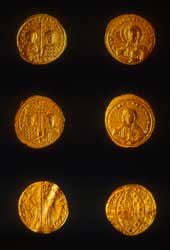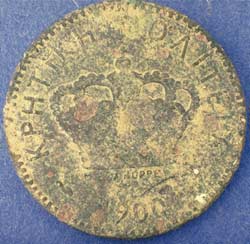Crete during the Mediaeval-Modern period (AD 824 - 1900)
 Pano Khora in upper Samaria Gorge, left of the white vertical scar (1989) © Sphakia Survey |
The invasion of Crete by the Arabs in the ninth century AD is a conventional turning point in the history of the island, marking the break between Antiquity and the Mediaeval period. The Arab period (AD 824-961) lasted some 135 years, though it has left very few material traces. The insecurity of the period is seen in the refuge sites built in remote locations (e.g. Pano Khora in the Samaria Gorge).
 Three Cretan coins. Top: Nikephoras Phocas and Blessed Virgin Mary. Middle: Basil and Constantine VIII. Bottom: Venetian ducat St Mark and Doge. © Ekdotiki Athenon |
The reconquest of Crete by the Byzantine emperor in 961 returned the island to an Aegean political and economic context, but the Byzantine empire in its turn fell to western powers. (See Byzantine period.)
 Modern Ag. Roumeli from sea, looking NE. On ridge running up from the sea to the right are two Turkish forts. On the ridge running up from the sea to the left is visible another Turkish fort (1995). © Sphakia Survey |
Crete was ruled by the Venetians from AD 1204, until it was captured by the Ottoman Turks in the middle of the seventeenth century AD. (See Venetian period, Ottoman period.)
 Prince George coin of 1900; crown. Found at Phoinix-Loutro. © Sphakia Survey |
Ottoman rule from Istanbul lasted from AD 1669 until the end of the nineteenth century, when the island was ruled briefly by the Great Powers (UK, France, Italy, and Russia, AD 1898-1913).
Crete was added to the emerging nation state of Greece in AD 1913, but AD 1900 marks a convenient moment to end this course.
The major sites in this epoch were Khania, Rethymno and Herakleion. We will look in more detail at Venetian Khania in Unit 3. The villages that exist to this day were formed in the course of the Venetian period. We will examine a village in Sphakia in Unit 4. Christianity continued to be the dominant religion on the island (though the Venetians introduced western versions to some places). The Ottomans respected the religious traditions of their subjects, but some people converted to Islam and mosques were built especially in the major cities.